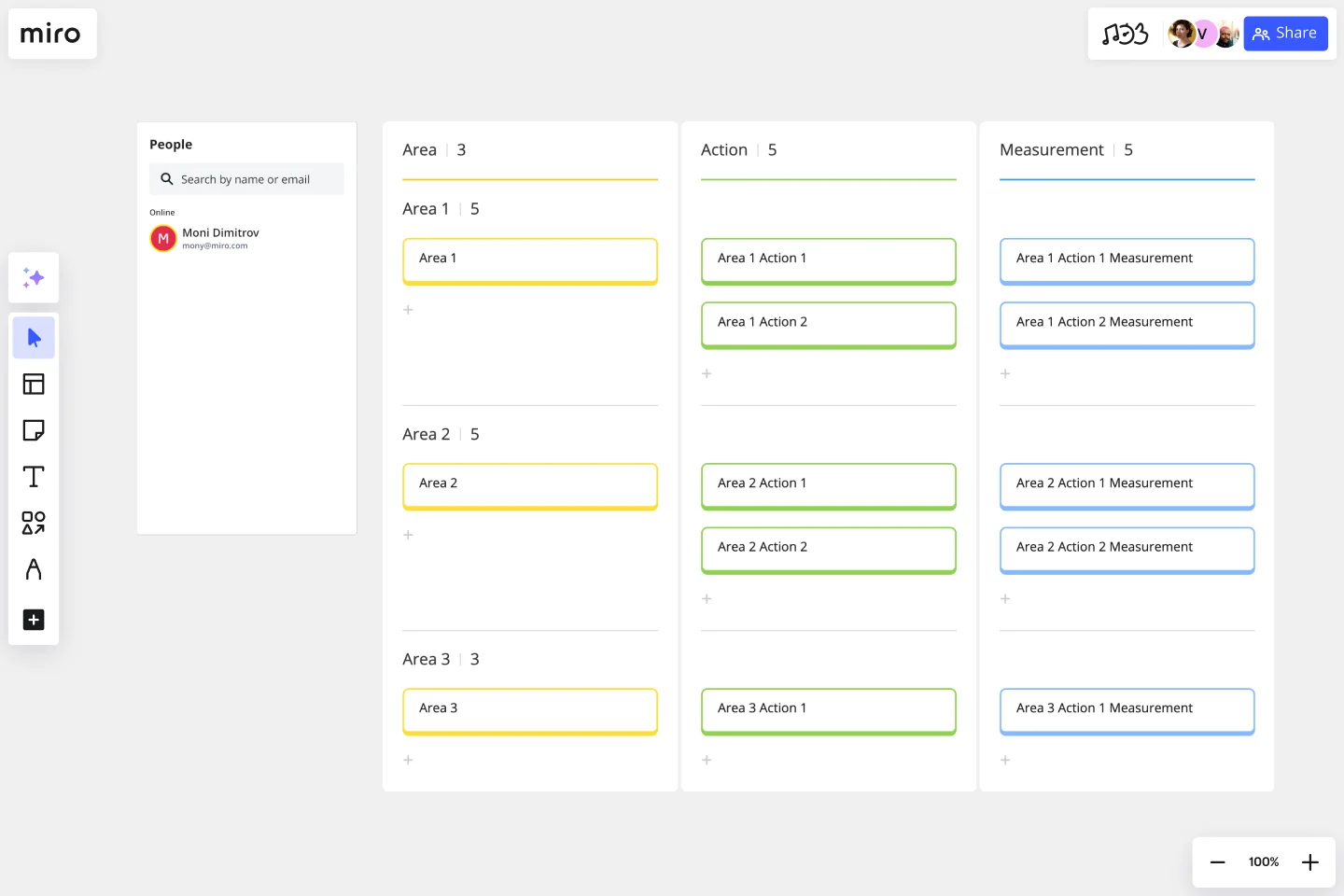Corrective Action Plan Template
Correct for any undesirable actions, outcomes, or behaviors that occur in the workplace. Document everything in a written framework with actionable steps using Miro’s template for corrective action.
About the Corrective Action Plan Template
Once in a while, a manager or HR representative must deliver a corrective action plan to an employee. It’s a difficult conversation, but when inappropriate behavior occurs or job performance fails to meet expectations, the best course of action is to document the infraction. Not only does it help drive the conversation between HR, the manager, and the employee, but it also paves the way for actionable next steps for improvement.
Keep reading to learn more about how to use this simple Corrective Action Plan Template.
What is a corrective action plan?
A corrective action plan takes difficult conversations — regarding behavior or job performance — and puts them into a professional, written framework so that the process, next steps, and details of the conversations are documented. A corrective action plan might include the following:
A write-up of the deficiency (behavioral or performance) and why it has created a disconnect in the expectations of the role.
An HR-approved template describing what is included in the corrective action plan and what steps must be followed.
A process of stop, start, and continue is clearly laid out.
Clarification of roles & responsibilities.
A specification of the ramifications of not following the corrective action plan.
This might seem like a lot of work for a manager or HR team member, but that’s why having an easy-to-use template is just what you need to simplify the tasks!
When to use corrective action plans
Corrective action plans aren’t always negative in nature. Sure, the most common use case might be combating behavior issues, but corrective action can also signal the need for sweeping changes within an organization or team. Put more simply: corrective action can be looked at like quality assurance within individuals or teams that pinpoints a problem, then sets out to fix a specific behavior, task, process, or product.
Create your own corrective action plan
When it comes to corrective action plans, the most important thing is eliminating murky communication, aligning expectations, and providing step-by-step instructions for your employee. Here’s how to create your own, using Miro’s easy pre-made corrective action plan template.
Set a deadline. Set a deadline for completing the steps for corrective action. Also make sure you clearly outline the consequences for not meeting the deadline.
Set priorities and realistic goals: Whether this is an action plan for an individual or a team, setting yourself up for success means setting up priorities and goals.
Document everything: Stakeholders, metrics, dates, expected resolution. Everything should be carefully documented so you have a record of the action plan.
Define the problem! Every corrective action plan must first start with a problem that must be addressed. Make sure you write this down.
Get started with this template right now.
Product Roadmap Canvas Template
Works best for:
Roadmap, Mapping, Planning
The IASA - Product Roadmap Canvas template offers a holistic view of product development by integrating key elements such as customer needs, business goals, and technology requirements. By utilizing this canvas, teams can align their product strategy with market demands and ensure that development efforts are focused on delivering maximum value to customers.
Floor Plan Template
Works best for:
Operations, Workshops
Maybe you’re planning a big occasion or event. Or maybe you’re arranging seating structures and traffic flows that are more permanent. Either way, creating a floor plan—an overhead scaled diagram of the space—is equal parts functional and fun. This template will let you visualize how people will move about the space and know quickly if the space will do what you need, before you commit time, money, or resources. And you’ll be able to get as detailed as you want—finding the right measurements and dimensions, and adding or removing appliances and furniture.
ERD Supply Chain Management System Template
Works best for:
ERD
The ERD Supply Chain Management System Template streamlines and optimizes supply chain operations. It serves as a visual support that helps businesses understand and manage the complex relationships between different entities within their supply chain, such as suppliers, products, inventory, orders, and shipments. By providing a clear visualization of these relationships, the template enables users to identify inefficiencies and areas for improvement, facilitating strategic decision-making.
Timeline-Retrospective
Works best for:
Timeline, Planning
Use the Timeline Retrospective template to review project progress and outcomes. It’s ideal for identifying what worked well and what didn’t, facilitating continuous improvement. This template helps teams reflect on their performance and make informed decisions for future projects.
Daily Schedule Template
Works best for:
Planning, Project Management
The Daily Schedule Template is a vital tool for managing daily routines efficiently. It helps plan and organize tasks, appointments, and priorities with great precision. Its adaptability allows users to allocate time efficiently, adjust schedules as per changing priorities, and navigate the day with ease. With this template, individuals can integrate daily activities with their broader goals, contributing meaningfully to their overall success.
Roadmap Mountain
Works best for:
Roadmap, Planning, Mapping
The Roadmap Mountain template provides a metaphorical framework for planning and visualizing project objectives and milestones. By depicting the journey towards achieving goals as a mountain ascent, teams can inspire motivation and focus. This template encourages collaborative goal-setting and fosters a sense of accomplishment as teams progress towards their summit. With clear milestones in sight, teams can stay motivated and track their progress effectively.
